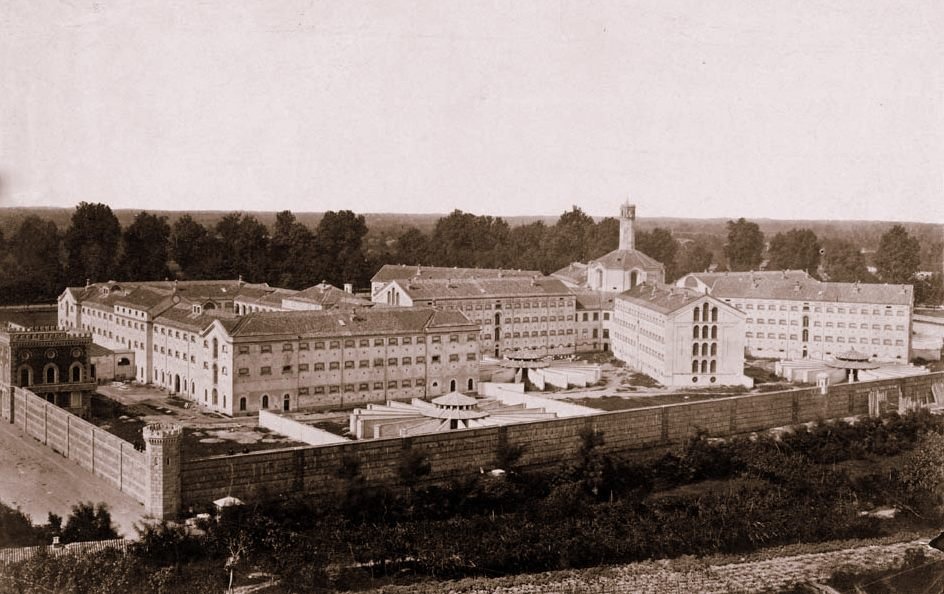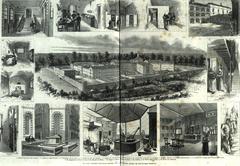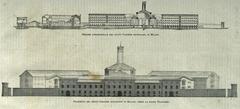
Carcere di San Vittore Visiting Hours, Tickets, and Milan Historical Sites Guide
Date: 14/06/2025
Introduction
Carcere di San Vittore, situated in the heart of Milan, is not only an active correctional facility but also a profound symbol of the city’s history, architecture, and cultural memory. Established in the late 19th century, San Vittore has played a pivotal role during significant historical epochs—especially World War II and the Fascist era—while also reflecting Italy’s evolving approach to justice, incarceration, and social welfare. Today, although public access is limited due to its operational status, the prison remains a subject of interest for historians, architects, and culturally curious travelers.
This guide provides a detailed overview of San Vittore’s history, architectural features, practical visitor information, and its broader significance within Milan’s urban fabric. It also includes tips for exploring nearby attractions and engaging respectfully with this sensitive site. Whether you are researching Milan’s penal history, planning to join a special guided tour, or simply seeking to understand one of Italy’s most emblematic prisons, the following sections will equip you with essential context and resources (mi4345.it; sestaopera.it; Artribune).
Historical Background and Architectural Features
Origins and Construction
Built on the site of the former Convento dei Cappuccini di San Vittore agli Olmi, San Vittore was designed in the late 19th century as part of Italy’s penal reforms (mi4345.it). Construction began in 1872 and the prison opened in 1879. Architect Francesco Lucca envisioned a facility with a panopticon-inspired radial layout: six wings radiate from a central hub, allowing for efficient surveillance and control—a concept reflecting contemporary European trends in prison architecture (thefunambulist.net).
San Vittore’s imposing exterior and austere interiors embody the penal philosophies of its time. The main complex covers over 50,000 square meters and includes a neo-Gothic front, intermediate body, and the distinctive central building with six radiating arms (Artribune). Unique among Italian prisons, San Vittore is embedded within Milan’s city center—inside the historic Spanish Walls—rather than on the urban periphery (Artribune).
Historical and Cultural Significance
During the Fascist regime and World War II, San Vittore became a key site for the detention of political prisoners, resistance fighters, and Jews prior to deportation. After the Nazi occupation of Milan in 1943, portions of the prison were commandeered by the SS, and conditions for detainees—especially Jews—were extremely harsh, with overcrowding and inadequate facilities (mi4345.it). The prison also served as a transit camp, with many prisoners sent from here to Milan’s Central Station and subsequently deported to concentration camps (Memoriale della Shoah).
Notable inmates have included figures such as Gaetano Bresci (the anarchist who assassinated King Umberto I), Aldo Spallicci (anti-fascist), and Indro Montanelli (journalist and historian) (AbsolutViajes). The memory of these events is preserved at the Memoriale della Shoah, which commemorates victims who passed through San Vittore.
San Vittore’s continued operation in the city center has sparked debate about its role in Milan’s urban life and the potential for adaptive reuse, such as conversion into a museum or cultural center (Artribune).
Social Realities: Overcrowding, Demographics, and Daily Life
Overcrowding and Living Conditions
San Vittore is Italy’s most overcrowded prison, with a capacity of around 477 but an actual population often exceeding 1,000 inmates (Corriere della Sera; MilanoToday). Cells intended for two may house up to five people, and summer heat exacerbates difficult conditions. Access to fans, rehabilitation programs, and communal areas is limited (Quotidiano.net).
Demographics and Health
The majority of inmates are foreign-born, many undocumented, and a significant portion are young adults aged 18–25 (AreacMilano). High rates of mental illness and addiction further strain resources, with insufficient access to treatment and support (Quotidiano.net). These factors contribute to increased incidents of self-harm and suicide; San Vittore’s suicide rate is among the highest in Italy (MilanoToday).
Daily Life and Rights
Inmates are entitled to four phone calls per month, and visits must be scheduled in advance. Many, especially foreign prisoners, receive few visits, relying instead on volunteers and NGOs for social contact and support (Quotidiano.net).
Staff, Security, and Community Engagement
San Vittore employs about 580 correctional officers—less than the recommended 700—adding to operational strain (Corriere della Sera). Labor unrest and staff shortages impact both safety and rehabilitation efforts. However, the prison benefits from strong community engagement, with volunteers, legal aid societies, and religious organizations providing essential services (Quotidiano.net).
Visiting Carcere di San Vittore: Practical Information
Can the Public Visit San Vittore?
San Vittore is not open for regular public tourism. Access is strictly limited to authorized visitors (legal representatives, family of inmates, and registered volunteers). However, special cultural tours or commemorative events are occasionally organized by associations such as MiGuidi (MiGuidi).
Visiting Hours and Tickets
- Regular Visits: Only for authorized individuals and must be scheduled in advance. Typically weekdays, but subject to change.
- Special Tours: Offered occasionally by cultural associations; advance booking is required. Most tours are free or low-cost and conducted in Italian.
- Tickets: There is no public ticketing system; tickets (when available) are reserved for special events (MiGuidi).
Booking a Tour
- Book via the association’s website or contact them directly.
- Tours are usually in Italian; inquire for language options.
- Group sizes are small for security reasons.
Accessibility and Photography
- Accessibility is limited due to the building’s age and security protocols; check with organizers for accommodations.
- Photography inside is generally prohibited; external images may be possible with permission.
Location and How to Get There
San Vittore is centrally located at Piazza Gaetano Filangieri, 2. The area is well-served by Milan public transportation:
- Metro Stations: S. Agostino (M2), Coni Zugna (M4)
- Bus Lines: 43, 65, 68, 94
- Trams: 9, 10
Nearby landmarks include the Museo Nazionale della Scienza e della Tecnologia Leonardo da Vinci and the Basilica di Sant’Ambrogio (Moovit).
Nearby Historical and Cultural Attractions
- Memoriale della Shoah: Museum and memorial to Holocaust victims (Memoriale della Shoah).
- Castello Sforzesco: Renaissance fortress with museums and art collections.
- Piazza del Duomo: Iconic cathedral and city center.
- Navigli District: Historic canals, nightlife, and galleries.
- Brera District: Art, cafes, boutiques.
These sites offer opportunities to expand your understanding of Milan’s history and culture.
Frequently Asked Questions (FAQ)
Q: Can tourists visit Carcere di San Vittore?
A: No, regular public visits are not permitted. Access is restricted to authorized individuals; special guided tours are rare and require advance booking.
Q: How do I book a tour?
A: Through organizations like MiGuidi, subject to availability and security protocols.
Q: Are there entrance fees?
A: Most tours are free or low-cost; details depend on the event.
Q: Is the prison accessible for people with disabilities?
A: Accessibility is limited; check with tour organizers.
Q: Can I take photos inside?
A: Interior photography is generally prohibited.
Respectful Engagement and Ethical Considerations
Given San Vittore’s ongoing role as a correctional facility and its sensitive history, visitors and researchers should approach the site with respect for the dignity of inmates, staff, and the broader social context. Participation in tours and educational events offers an opportunity to reflect on themes of justice, memory, and urban transformation.
Visuals and Media
- Exterior view of Carcere di San Vittore with alt text “Carcere di San Vittore prison exterior in Milan”
- Map showing central location and nearby cultural sites
- Infographic: Prison overcrowding and demographics
Final Tips and Summary
Carcere di San Vittore exemplifies the intersection of Milan’s penal heritage, architectural innovation, and social challenges. While regular public visits are not possible, rare guided tours and commemorative events provide meaningful insight. Combine these experiences with visits to nearby historical landmarks for a richer understanding of Milan’s complex past.
Stay informed by consulting official tourism resources, booking tours well in advance, and using digital tools such as the Audiala app for guided information and updates. Always approach your engagement with San Vittore thoughtfully, honoring the history and lives connected to this landmark (yesmilano.it; MiGuidi; Memoriale della Shoah).
References and Further Reading
- Visiting Carcere di San Vittore: History, Architecture, and Practical Visitor Information in Milan, 2024, mi4345.it
- Sesta Opera San Vittore Information, 2024, sestaopera.it
- San Vittore Prison in Milan: History, Visiting Hours, Tickets, and Visitor Guide, 2024, Memoriale della Shoah
- Carcere di San Vittore Visiting Hours, Tickets, and Milan Historical Sites Guide, 2024, MilanoLife
- Carcere di San Vittore: Visiting Hours, Tickets, History & Milan’s Historic Prison Tours, 2024, Artribune
- MiGuidi Guided Tours Information, 2024, MiGuidi
- Official Milan Tourism Website, 2024, yesmilano.it





























































